Fomentations
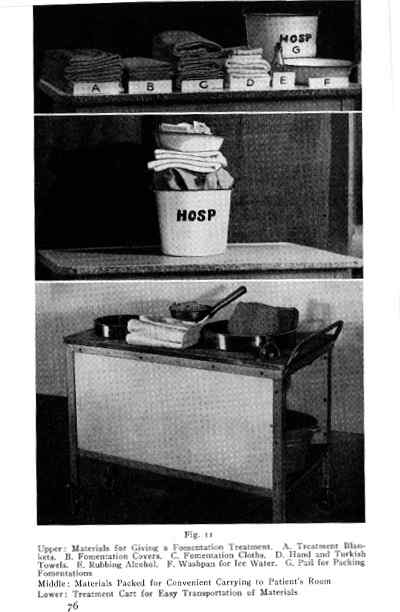
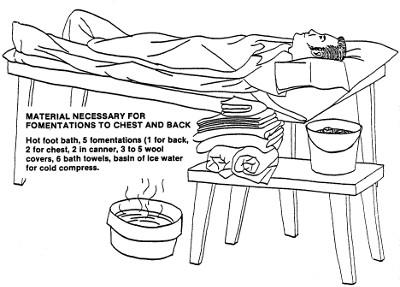
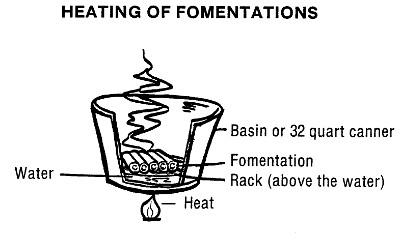
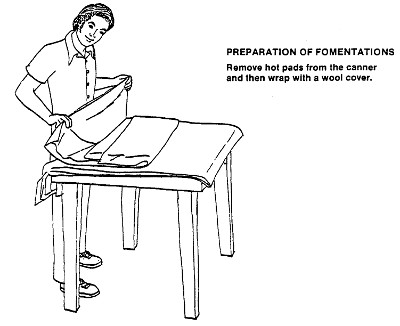
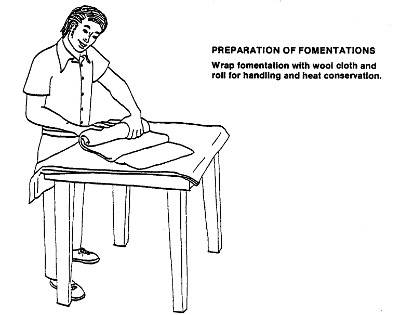
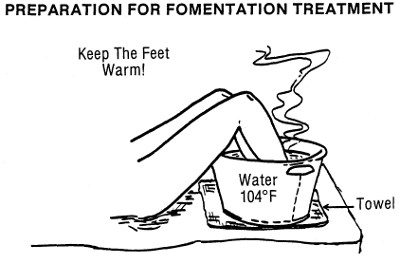
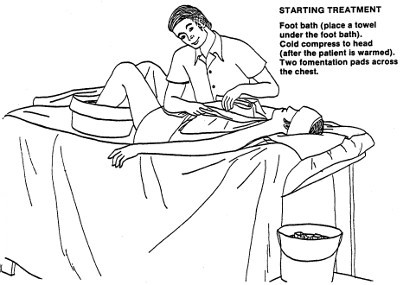
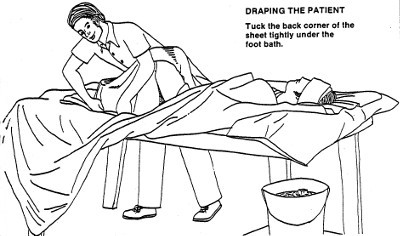
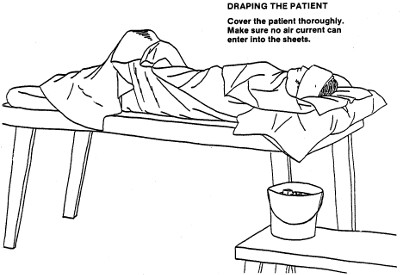
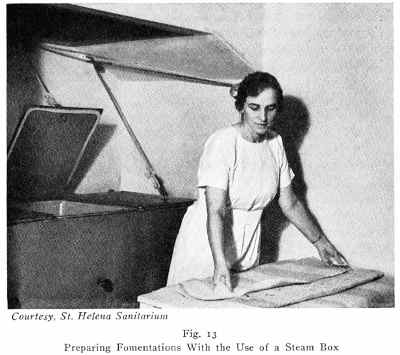
HYD
from Hydrothermic Remedies...
"Various methods may be used for the application of heat to the body surface, but of all methods there is perhaps no more effective or simpler method than the use of cloths wrung out of boiling water. This... is known as fomentations." Physical Therapy in Nursing Care, p. 74.
Large wet, hot applications, usually wool-mix cloths to produce skin hyperaemia. Cloths are changed as they cool SYN: foments
Effects:-
- Derivative
- Enhances the Immune System
- Sedative
- Analgesic
- Sudorific
Definition
A fomentation consists of a local application of moist heat to the body surface. A fomentation is usually made of blanket material: 50% wool to retain heat and 50% cotton to retain moisture and be more durable.
Physiologic Effects
- Promotes increase in circulating white blood cells
- Increases blood flow to the skin, thereby relieving internal congestion
- Relieves muscle spasm by increasing circulation and releasing muscle tension
- Relieves pain in muscles and joints by counter-irritation and decongestion
- Reflexly relieves pain from internal organs
- Increases elimination by promoting sweating
- Stimulates or sedates according to the temperature of the application
Indications
- Joint Pain
- Neuralgia and Neuritis Pain
- Muscle Tension
- Insomnia
- To warm the tissues in preparation for massage
- To prepare for cold procedures
- Active Chest Congestion in Colds, Influenza, Bronchitis, Pleurisy (no cold used for pleurisy)
- Nervous Tension- sedative to spine
- To produce sweating
Contraindications and Cautions
- Loss of skin sensation due to,
- Unconsciousness
- Paralysis of the part
- Legs and feet of diabetic
- Leg or feet Oedema, Varicose Veins, Advanced Vascular disease
- Malignancy
- Tendency to bleed (haemorrhage)
- Stomach or bowel ulcers
- Omit cold in extreme pain such as Pleurisy, Renal Colic and Dysmenorrhoea.
Equipment
- Large wool blanket - 1
- Sheet - 1
- Pillow - 1
- Large buckets - 2
- Oral thermometer (optional)
- Towels - 10
- Water thermometer
- Blood pressure cuff and stethoscope
- Fomentation pads and covers - 5 each
- Large kettle or canning kettle - 1
- Basin of ice water
- Friction mitts
- One or two compress cloths
Preparation of the Fomentation
Boiling Water Method
- Fold a large bath towel lengthwise and twist as much as possible; place middle three-quarters into boiling water and let it become thoroughly soaked.
- Lift out of water and pull hard to wring out all the water possible. Let it untwist by dropping one end and hold the other end.
- Lay it over the towel placed on the patient's body if the towel is very hot.
OR
Place hot towels on the skin surface and quickly remove it to avoid burning; watch it very carefully to lift the towel if heat is not tolerated. The towel will cool off rapidly. Practice this skill thoroughly before you work on your client. - Cover with another towel
- Repeat procedure 3 or 4 times. In between the hot towels, briskly wipe the body surface with ice-cold cloth and then blot the moisture quickly. It the moisture that burns the skin, therefore the skin must be dry completely before the next application.
Steaming Method
- Soak completely and wring out 5 large bath towels or fomentation pads in water
- Place the towels or pads on the grid of a large canner (32 qts or ltrs)
- Place enough water in the canner below the grid and boil it for 20 minutes - towel or pads should not touch the water.
Micro-wave Method
- Take a large bath towel soaked in cold water; wring out all the water possible.
- Place the single towel in a black plastic garbage bag or other strong plastic bag
- Place the bag in the micro-wave oven and turn to high for 4 minutes (or until steaming)
- Quickly remove towel and use it on the body surface; if it is very hot, place a dry towel on skin area before applying the very hot towel.
Procedure
Important Considerations
- Be sure the water in the Hot Foot Bath does not burn the patient; consider the age and vitality of the patient.
- Always ask if fomentations are burning the patient. If they are too hot, lift the fomentation, dry the skin and add another towel between the patient and the fomentation.
- Be sure the patient is always properly draped
- Know the patient's condition before you start.
- Always have the room warm before you begin treatment; make sure there are no drafts.
- Remember that the duration and frequency depends on the desired result.
- Stimulant: applications should be short (3-5 minutes) very hot, and followed by cold or with cold between fomentations. Causes mild fluxion.
- Sedative: applications should be longer (6-10 minutes, but not longer than 20 minutes) with milder heat.
- For CVA (stroke): warm not hot, less than 20 minutes and follow with cold.
- Be especially careful with thin or aged persons and children
- Avoid chilling
- Be careful not to spread infection
- Keep towels under fomentations dry, moisture will increase the chance of burning the patient.
- Parts where bone is close to the skin surface are especially apt to burn (due to less blood flow), so keep extra towels on hand to use to protect these areas more if necessary.
Preparation for Treatment
- Explain procedure to patient
- Have the room warm and free of drafts; secure privacy
- Have the patient remove clothing, drape with sheet. For bed patients, cover with bath blanket and remove gown.
- Be sure the person's feet are warm; if heat is not ordered (arteriosclerosis, diabetes etc.), cover feet with a warm blanket
- For treatment of post-operative areas, cover all dressings with a plastic protector before applying the fomentation.
- A plastic cover may also be used to help retain heat if the application is ordered for long periods.
- If cerebral congestion may occur, have cold compresses to apply to neck as well as to the head. In heart disease or with pulse of 130 or above, place an Ice Bag over the heart.
Treatment
- Have all the equipment ready
- Take the patient's temperature and record it
- Take pulse and respiration and record
- Take and record blood pressure
- Have patient disrobe
- Have blanket on bed or table then place sheet on top of blanket
- Have patient lie on sheet and wrap blanket completely around the patient exposing only his head
- Prepare the water in bucket for the Hot Foot Bath (40°C / 104°F); fill the bucket only half full; place your hands under the patient's feet and you lower them into the water. Completely wrap the bucket and the legs with the sheet and the blanket.
- Cover part to be treated with bath towel.
- Use intensity of heat as indicated by the patient's condition and effect to be desired.
- Apply fomentation to area as indicated. To relieve congestion, have fomentation extend over a large area; for local effect, make the fomentation the size of the area.
- Apply one fomentation under the patient's back
- Apply two fomentations across the chest, leave for 3-5 minutes; when the fomentation becomes comfortable, that is the time to change.
- Protect sensitive parts and bony prominences with as many towels as are necessary.
- Lift fomentation and rub hand firmly over the towel to remove moisture if unbearably hot; if necessary place another towel between fomentation and patient, placing the dry towel next to the skin.
- Apply Cold Compress to head and/or neck; change every 2-3 minutes; use Ice Bag to heart if needed.
- Give three fomentations unless otherwise indicated, applying Cold Mitten Friction to the area between each application. Be sure to dry part well before applying another fomentation; change towel that next to the skin if it becomes the least bit damp.
- After last fomentation, rub area with Cold Compress and dry thoroughly; cool patient with Cold Mitten Friction to entire body. Be sure to leave the patient with a dry body, gown, sheets and blankets. Any dampness will cause a chill and make the person worse.
- In cases of severe pain, have the fomentation as hot as can be tolerated.
- Omit cold in extreme pain such as Pleuritic Pain, Renal Colic and Dysmenorrhoea.
- Warm alcohol may be used for astringent effect and to cool the patient.
- If further sweating is required, finish with: Blanket Wrap
Completion of Treatment
- Leave the patient comfortable and free of perspiration
- Encourage patient to rest for at least 30 minutes before dressing
- Remove equipment and leave area tidy
- Record treatment, frequency and length of application
- Report the effect of the treatment, the reaction of the patient, and any deviation of results noted
- Be sure the patient is not going to perspire in his clothing.
JHK
from Dr JH Kellogg's Hydriatic Techniques...
- Follow with short cold
- use vaseline before daily treatments
Preparation for cold
- 10 minutes to abdomen before Cold Tub Bath
- or cooling Wet Sheet Pack - during Cold Enema
- Alternate with Cold Compress if difficult to get sweating
- prevents shivering and abdominal cramps and pain
Derivative, Revulsive, Antiphlogistic and Analgesic
- Directly over part, as hot as possible, 20min then
- Cold Compress or Heating Compress over area in interval, repeat 1-2hrs in...
- acute Visceral Inflammation in
- Pelvic Inflammation and Pelvic Congestion in
- Orchitis
- Kidney Inflammation
- Rectal Pain
- Vaginitis
- Ovaritis
- Chronic Metritis to hypogastrium, thighs and perineum,
- Prostatitis to perineum
- Abdominal Pain in
- Haemorrhoids, Irreducible Rectal Prolapse - apply direct then reduce after heat, if unreduced repeat every hour 10min
- Muscle Inflammation, Osteoarthritis
- Throat Inflammation of larynx, Tonsillitis, Diphtheria
- Syncope in Haemorrhages often fatal, prevention: moderately hot Fomentations to neck and top of head
- Dislocations and Fractures, 20min before and after setting then Heating Compress lightly covered in dislocation
- Headache of any sort - over spine, head, neck or stomach in Anaemic Headache,
- Joint Pain 4x daily with Heating Compress at night
- false and true Croup to throat with Heating Compressafter
- Mustard Fomentation: powerful skin stimulation see Mustard Bath
Analgesic Excitant
5-10 min every 2hrs, as hot as the patient can bear, wrung very dry, Cooling Compress or Heating Compress in interval in:
- acute Local Skin Inflammations, early Erysipelas, Boils
- Swollen Painful Joints, Articular Effusions, Exudate,
- Muscle Spasm, Sprains, muscle tears, Trigger Points,
- Visceral Anaemias, local Infections
- Neuritis Pain in
- acute Neuralgia, acute Rheumatoid Arthritis - no cold, leave the fomentation on till skin temperature (15min) then remove, dry, cover
- Active Chest Congestion in
- Heart Failure or Collapse in
Cooling Compress or Ice Bag to heart in interval
- Hepatic Inactivity, irreducible Hernia
- Retention Fevers to spine followed by Cold Mitten Friction
- Renal Inactivity in Renal Congestion or Acute Nephritis - over whole lower back, follow by Cold Mitten Friction 1min then Heating Compress 30min and repeat
- Cerebral Hyperaemia, Nervous Headache, Sensation of Coldness, Numbness or Pressure - light fomentation to neck, back, top of head and face, change 2-3min
- Cerebro-Spinal Congestion of Meningitis
- Gastric Pain in Hyperpepsia - when pain or 30min after meals
- Toothache, Migraine, Earache - on face only Ice Bag or Cold Compress below jaw or on the neck
- Spinal for Urine Incontinence in Chorea - over anus
- Tympanitis in Typhoid Fever, Celiac Irritation and all its Reflex Irritations to abdomen
Contra-indications
- Paralysis or reduced sensation
- Hyperaesthesia of the skin
- intense Flatulence with Gas distention of intestines
GKA
from Dr GK Abbott's Prescriptions...
Precautions:
- Avoid burning when sensation is not intact
- Place gauze next to skin when given to face
- If general sweating use Cold Mitten Friction
- Protect bony prominences (ilia, costal arches, clavicles and scapula) with extra towels
- In fever or if danger of cerebral congestion apply cold to neck and head
- If rapid pulse use Precordial Compress
Effects:
- Analgesic: as hot as possible renewed as soon as it becomes comfortable
- Derivative
- Preparation for cold treatment
- Stimulating - brief and hot followed by cold
- Sedative - prolonged moderate application
Hydrotherapy Techniques:
Local Applications
Compresses and Packs
- Abdominal Heating Compress
- Alternate Compress
- Cold Compress
- Cooling Compress
- Cooling Coil
- Dry Abdominal Bandage
- Evaporating Compress
- Fomentations
- Graduated Compress
- Head Alternate Applications
- Head Pack
- Heating Compress
- Heating Trunk Pack
- Hot Coil
- Hot Compress
- Hot Water Bottle
- Ice Bag
- Ice Cap
- Ice Collar
- Ice Compress
- Irrigated Compress
- Mustard Fomentation
- Neutral Compress
- Proximal Compress
- Revulsive Compress
- Scotch Compress
- Simultaneous Hot and Cold to Head
- Spinal Alternate Applications
- Spinal Pack
- Thermophore
- Wet Girdle
